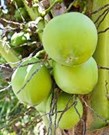VIETNAM'S RAW COCONUT PRICE FLUCTUATIONS
The Vietnamese coconut industry has more than 200,000 hectares of raw material area with an average output of 2 million tons per year, including the Central and Southern regions. If in 2015, Vietnam had 8 export factories, by 2024 there will be 45 factories producing and processing coconut products and products related to Vietnamese coconut for export. In particular, many high-tech factories, raw material areas of tens of thousands of hectares meeting international standards to serve the needs of producing high-quality products have affirmed their product brands in the international market such as Ben Tre Import Export Joint Stock Company - Betrimex, Luong Quoi Coconut Production Company Limited, Ben Tre Coconut Investment Joint Stock Company - Beinco, Viet World Company Limited - VietWorld, Asia Coconut Processing Joint Stock Company - ACP ...
Vietnam's coconut industry and its growth momentum since 2018 after the efforts of the Vietnam Coconut Association to participate in international fairs and attend many trade promotion forums displaying and introducing products of Vietnamese coconut enterprises. The trust signal of coconut farmers is based on the price of raw coconut purchased by traders at the garden for farmers. Normally, the price of raw coconut in the Central region is often higher than the price of raw coconut in the Southern region (Mekong Delta) by about 10%.
The price of raw coconut purchased at the garden. Unit / 1 fruit/ USD
| Area | 2022 | 2023 | 2024 | 2025 | ||||
| Raw coconut | Fresh coconut | Raw coconut | Fresh coconut | Raw coconut | Fresh coconut | Raw coconut | Fresh coconut | |
| Central Vietnam | 0.24 | 0.16 | 0.36 | 0.40 | 0.72 | 0.68 | 0.76 | 0.72 |
| South Vietnam | 0.12 | 0.12 | 0.20 | 0.16 | 0.48 | 0.52 | 0.76 | 0.64 |
The price of raw coconuts has increased due to the following reasons:
Firstly, the impact of climate change causes prolonged hot weather, and raw coconut trees that flower in hot weather often drop fruit. If the average time from flowering to harvesting is usually 10-11 months, the prolonged drought and water shortage often causes the harvest time to be 13 months. In addition, the impact of the lack of water from the Mekong River causes saline intrusion to occur more frequently and more deeply in the Mekong Delta provinces, affecting the yield and quality of coconut trees.
Techniques for planting and caring for coconut trees are still limited, only 20% of farmers care about caring for coconut trees, farmers do not pay attention to fertilizing, monitoring pests and diseases and preventing pests scientifically, which has affected the yield of coconut trees. The recent widespread appearance of Brontispa longissima beetles, coconut worms, or black-headed caterpillars has reduced the productivity of raw material areas of enterprises and reduced the income of farmers.
Second: Traders collect raw materials to export in raw form (dried coconuts) and peeled coconuts (coconuts with shells intact) to export to countries such as China, India, Israel, Cambodia and Thailand. During peak times (around the second quarter - third quarter of 2024), many rudimentary vehicles transport coconuts through border gates between Vietnam and Cambodia in the provinces of Tay Ninh, Long An, Dong Thap and An Giang every day. The massive informal export has increased the price of raw coconuts supplied to factories, and the peeling and preliminary processing stages taking place abroad have also increased the market for copra, coconut husks and coconut shells.
Deep processing enterprises in the coconut industry from China have been interested in investing in factories to purchase raw materials, pre-process such as frozen coconut water, frozen coconut milk, whole coconut shells, for export to Hainan, Guangxi, Guangdong, Yunnan provinces ... China, then deep processing to produce products for the market. These enterprises are often concentrated in Ben Tre province to use geographical indications of raw materials originating from Ben Tre - Vietnam.
Third: The use of coconut products, products with raw materials related to coconut has also increased. Commercial enterprises quickly entered the market to do business, find customers and process products to supply the market to meet consumer needs.
In 2023, the US approved Vietnamese fresh coconuts to be officially imported into the US market with certain technical barriers, creating a trade wave of agricultural enterprises interested in fresh coconut products for export. In August 2024, China officially approved the official import of Vietnamese coconuts, causing many events of connection and trade between business delegations of the two countries to explode, and Chinese media paid attention to and highly appreciated the quality of Vietnamese coconuts. Since then, Vietnamese coconuts and Vietnamese coconut products have competed fairly with products from other countries, creating a domino wave of response and search by other markets such as the Middle East and Europe.
The export of fresh coconuts is a good sign, but besides that, the massive export of raw coconuts (dried coconuts) is also a worrying sign. The local source of raw materials is unstable, so some large factories and many coconut industry enterprises have begun to shift their investment plans to other countries in the region.
The high price of raw coconut brings significant profits to farmers, but it is difficult for deep processing enterprises when they have difficulty increasing product prices on the international market while they are the most stable and long-term and sustainable source of consumption for farmers. The Vietnam Coconut Association has grasped information and developments in each region and proposed many specific plans to limit the loss of raw materials, protect investors and sustainable benefits for farmers. From June 16, 2025, the price of raw coconut tends to decrease temporarily by about 30%, due to the source of raw coconut imported from Indonesia and the information that the Vietnam Coconut Association submitted to the government to impose taxes on raw coconut for export, making import enterprises hesitant to sign long-term orders. In addition, entering the rainy season, drought and water intrusion have decreased, and coconut productivity is higher. It is assessed that temporary price reduction requires specific plans to support farmers and not affect the market.




















